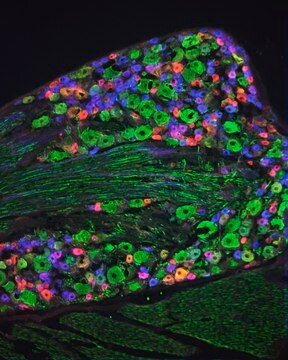MAB5262
Anti-Neurofilament H (200 kDa) Antibody
CHEMICON®, mouse monoclonal, RT97
Synonim(y):
Anti-CMT2CC, Anti-NFH
About This Item
Polecane produkty
product name
Anti-Neurofilament 200 kDa Antibody, clone RT97, clone RT97, Chemicon®, from mouse
pochodzenie biologiczne
mouse
Poziom jakości
forma przeciwciała
purified immunoglobulin
rodzaj przeciwciała
primary antibodies
klon
RT97, monoclonal
reaktywność gatunkowa
mouse, human
reaktywność gatunkowa (przewidywana na podstawie homologii)
rat
producent / nazwa handlowa
Chemicon®
metody
immunohistochemistry (formalin-fixed, paraffin-embedded sections): suitable
western blot: suitable
izotyp
IgG1
numer dostępu NCBI
numer dostępu UniProt
Warunki transportu
wet ice
docelowa modyfikacja potranslacyjna
unmodified
informacje o genach
human ... NEFH(4744)
mouse ... Nefh(380684)
rat ... Nefh(24587)
Opis ogólny
Specyficzność
Immunogen
Zastosowanie
1-10 μg/mL
Immunohistochemistry(paraffin):
Representative images from a previous lot.
Optimal Staining With Citrate Buffer, pH 6.0, Epitope Retrieval: Human Cerebellum
Optimal working dilutions must be determined by end user.
Neuroscience
Neurofilament & Neuron Metabolism
Neuronal & Glial Markers
Jakość
Western Blotting Analysis:
1:500 dilution of this antibody detected NEUROFILAMENT on 10 µg of Mouse brain membrane lysates.
Opis wartości docelowych
Postać fizyczna
Przechowywanie i stabilność
Komentarz do analizy
Brain
Cultured neurons
Inne uwagi
Informacje prawne
Oświadczenie o zrzeczeniu się odpowiedzialności
Nie możesz znaleźć właściwego produktu?
Wypróbuj nasz Narzędzie selektora produktów.
polecane
Kod klasy składowania
10 - Combustible liquids
Klasa zagrożenia wodnego (WGK)
WGK 2
Temperatura zapłonu (°F)
Not applicable
Temperatura zapłonu (°C)
Not applicable
Certyfikaty analizy (CoA)
Poszukaj Certyfikaty analizy (CoA), wpisując numer partii/serii produktów. Numery serii i partii można znaleźć na etykiecie produktu po słowach „seria” lub „partia”.
Masz już ten produkt?
Dokumenty związane z niedawno zakupionymi produktami zostały zamieszczone w Bibliotece dokumentów.
Nasz zespół naukowców ma doświadczenie we wszystkich obszarach badań, w tym w naukach przyrodniczych, materiałoznawstwie, syntezie chemicznej, chromatografii, analityce i wielu innych dziedzinach.
Skontaktuj się z zespołem ds. pomocy technicznej





